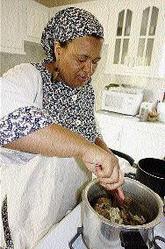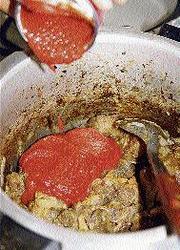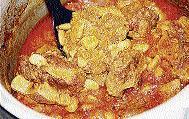
Elinor is ensuring that her oxtail is not a disaster. Rosemary Parkinson, Contributor
Three amazing women's lives intertwined over food. Two South Africans, one Dominican. I begin with Elinor Sisulu; the daughter-in-law of Walter and Albertina Sisulu; wife of their son, Max, and the mother of three boys.
I first met Elinor Sisulu dressed simply in African ensemble (no head-dress). I liked her immediately. On a cricket mission from a woman's perspective, she was also on a lecture tour of the Caribbean under the auspices of the Centre for Gender Development and Studies at the University of the West Indies (UWI) sponsored by CEPHIS. Residing in South Africa, the Zimbabwe-born is the media and advocacy manager, South African Desk, of the Crisis in Zimbabwe Coalition. She literally cries over her country. Also an author, she published a 672-page book: Walter & Albertina Sisulu - In Our Lifetime.
Walter Sisulu was in jail for 26 years with Nelson Mandela. In the foreword of her book, Mandela writes: "Often in addressing younger people, I make the point that what counts in life is not the mere fact that we have lived - it is what difference we have made to the lives of others that determines the significance of the life we lead. There can be no greater and more inspiring example in the history of our organisation, and hence our country, than Walter and Albertina Sisulu: a couple whose every deed spoke of leadership that made the kind of difference that brought us to where we are today as a country and as a people."
Elinor has captured these lives, not just by their deeds, but by referring to family history when Africa was truly Africa; white men slowly coming to the fore. And then, 1912. A huge gathering of tribes, chiefs of royal blood, of educated Africans "and the departed spirits, among whom were such men as Sandile, Tshaka, Moshoeshoe,Cetywayo, Moroka, Khama, Sekhukhune, Soshangana and Ramapulana, gathered together to discuss the discovery that in the land of their birth, white people had formed the Union of South Africa, and Africans were being treated as "hewers of wood and drawers of water". Their decision was to devise together "ways and means of forming our national union for the purpose of creating national unity and defending our rights and privileges." This was the beginning of a native congress, later renamed the African National Congress (ANC), the basic subject of Elinor's book with all the heartache and struggles that brought a ruthless apartheid government to its knees.
Epic saga
After the release of Walter on October 15, 1989, and the subsequent death of her father, Elinor said, "We find the unwritten and undervalued knowledge within our families and communities which is passed on through oral traditions in an increasingly haphazard way." And: "My feelings reinforced my own concern about the lack of documentation of the social history of black communities. Where better to start than with the lives of Walter and Albertina Sisulu? Theirs is a story of persecution, bitter struggle and painful separation. It is also of patience, hope, enduring love and ultimate triumph. It is an epic saga of two people who rose from humble beginnings to become two of the most influential South Africans of the 20th century - in short, a biographer's dream."
NKOSI SILELEL' IAFRIKA(God Save Africa)
Walter Sisulu, in the book, talked about early days, the importance of owning land; the way farm stock - cattle, sheep, goats and horses - determined one's standing in the community. There was stick-fighting (ukubetha iintonga), amongst the young ones that showed ability to cope with life.
Today in the Caribbean, the stick-fighting tradition remains, shown at particular island festivals. The abundance and love of wild fruit - wild figs, wild berries (manuqube), wild carrots (mangontsi), a grape-like fruit (mnqabaza), wild olives (isiphingo) - seemed every Caribbean food was prepared in three-legged pots on open fires (still happening here), and children gathered around the fireside chatting and exchanging anecdotes (a custom of eating together we desperately need to revive).
Influence of foreigners
Elinor says South African cuisine changed from indigenous dependence on wild game to farming with influences of colonists from Netherlands, Germany, France and Britain and immigrants from India. 'Cape Dutch' cuisine mixes European cooking with spices - nutmeg, allspice and hot peppers. There's much cattle, every part used. Frikkadels, small hamburgers seasoned with nutmeg, are sometimes wrapped in cabbage leaves and served with yellow rice. Bredie is a 'one pot meal'. Stews of mutton and vegetables. Pork and beef sausages curry favour.
Talking curries, they come in sweet, mild and hot, served with sambals (chopped vegetables), atjar (pickles) or blatjang (chutney). The latter two made with local fruits cooked with garlic, peppers, onions (sometimes curry powder), then pickled. The coastline brings abundant seafood, especially rock lobster. Crayfish are braised with onion and chillies or curried; salt cod is prepared with hot chilli peppers. Pickled 'snoek' fish abounds. There's a bevy of deciduous fruits with the naartjie an indigenous tangerine from which a liqueur called Van der Hum is made. Personally, I see a lot of food connections.
Elinor and friends agreed to cook for a group of cricket fanatics. Her dish was one of Jamaica's favourites - oxtail. The oxtail is soaked in brine of thyme and chives overnight. Pressure cooked in two cups water and plenty garlic, some salt, the oil off the water removed, the oxtail is then drained and fried in this oil until brown. Onions, tomato puree and ground black pepper are added. Once the oxtail is soft, butter beans follow and a taste for extra spices if required. When cooked with green beans instead of butter, fresh tomatoes are used. Oxtail is also curried using turmeric, curry and cumin.

The onions are followed by tomato puree.

One last stir to perfection once the butter beans are in. -Photos by Rosemary Parkinson
NEXT WEEK - Helen Moffet, editor of Elinor's book and 'ghost writer' of the late Coach Bob Woolmer's book, serves up Bobotie and talks about Rooibos.

